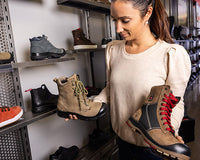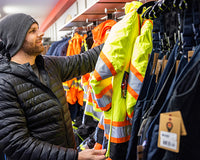As we all know, the Quebec winter can sometimes make it difficult for us to decide what to wear. The choice of your clothing is essential to spend your day dry and warm. To help you make the right choice of coat for the winter season, here are our tips.
Determine your needs
Keep in mind that not everyone has the same needs and faces the same reality. Coat strength, lightness, thickness, waterproofing, price, comfort level and preferences differ from one person to another. It is important to assess your needs and determine what will work best for you.
The duration of exposure to the outside temperature is an important criterion for the selection of the coat. The primary use of the coat will also become a major incentive for your final choice. For example, a person who wants to walk to work will not look for the same type of coat as someone who works outside all day. Finally, the type of activity you do will allow us to suggest a coat that is appropriate for your reality.
Our recommended products
It is strongly suggested to wear several layers when you are active. Put on an undergarment, a middle layer (fleece sweater or other) and your coat. This will allow you to change your clothing throughout the day and adapt to your activity and the weather.
More and more users are turning to 3-in-1 coats, which provide interesting warmth. They have a very useful versatile side. The outer shell is usually waterproof and windproof. The inner layer is lined and warm. The coat can therefore be broken down and worn from early fall to late spring.
Additional features to consider
It is easy to get lost in the multitude of information that can be found on the different coat labels. Let's take the time to differentiate the technical points that can be found on certain coats.
Waterproofing and water resistance
The degree of waterproofness or water resistance of a coat corresponds to its capacity to resist water or to prevent it from passing through the component of which it is made. The way to test the waterproofness of a garment is to place, on a sample of the garment, a column graduated in millimeters which will then be filled with water. This process allows to determine at which pressure the sample becomes waterproof. A coat with a pressure of 2000 mm or more will be considered waterproof. Below that, it will show some resistance to water.

Breathability
It is recommended to have a coat that breathes well when you are active. To find out the breathability of a coat, it is given a test that will calculate the amount of water vapor that the fabric will let through in 24 hours. The higher the degree, the better the breathing. A breathable coat will generally allow 5000g/m² or more of water vapor to pass.

Insulation
Most of the coats we sell are made with synthetic fiber. Synthetic insulations have the ability to dry faster, are easier to maintain and, as a bonus, are less expensive than a down jacket. The quality of an insulation is based on its ability to retain air. The more easily an insulator traps air, the more it can withstand low temperatures.

Which model to choose?
Choose a coat that you are comfortable and at ease in. Whether you are going to be outdoors for a short or long period of time, it is essential to select a coat that will respect your needs.
For example, if you wear your coat repeatedly in the snow or on rainy days, you will need to think about its waterproofness. If, while wearing your coat, you are static, without moving, you will have to think about choosing a coat with better insulation. Finally, if you wear your coat and hang it up frequently, you will need to choose a coat that is more resistant.
There is no doubt that choosing a winter coat can seem complex. This is why it is possible for you to speak with one of our consultants who will offer you their support in your quest for a coat.




